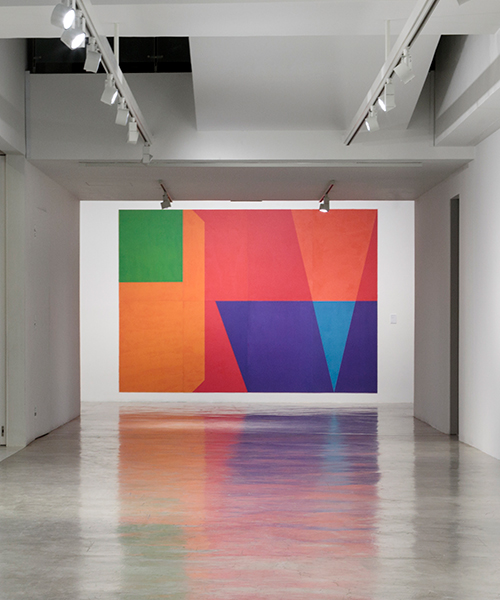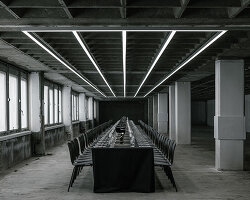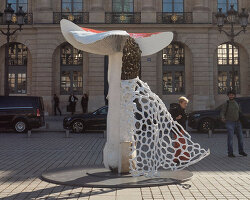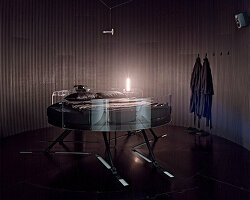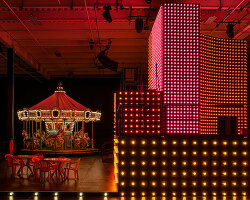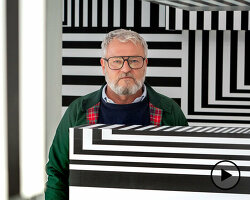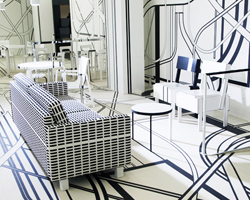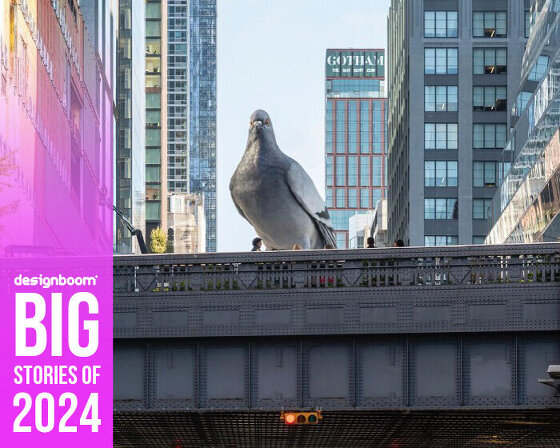exquisite trust (blindly collective collaborations) is an exhibition taking place at the STPI – creative workshop & gallery in singapore from march 18th to april 22nd, 2017. a collaboration between four major international artists — carsten höller, tobias rehberger, anri sala and rirkrit tiravanija — the exhibition represents a joint undertaking on the part of the four creatives to realize a series of experimental artworks created through blind experimentation and artistic exploration.
the project is organized in the form of a cadavre exquis (exquisite corpse), an artistic technique used by the surrealists whereby one artist partially completes a work before handing it off to another to finish, giving the subsequent contributors only a small indication of what the original section looks like. free from authorial intent and the mark of a single artistic style, the result is a composite work of original and unreserved expression, guided only by chance.

(above) (dreams that money can not buy) (detail) 2016; carsten höller, tobias rehberger, anri sala & rirkrit tiravanija
produced at STPI – creative workshop and gallery singapore © the artists/STPI
(main) all together. in your way. out of hands, 2016, carsten höller, tobias tehberger, anri sala & rirkrit tiravanija, produced at STPI – creative workshop & gallery, singapore © the artists/STPI
with four vastly different artistic sensibilities at work on a single piece, ‘exquisite trust (blindly collective collaborations)’ represents a relinquishment of power of behalf of those involved. no one artist had any greater insight into what the final outcome would look like, a challenge that marked a first for both the artists and the STPI – creative workshop & gallery team. recently, designboom picked the brains of the four contributors, getting some insight into the process and practices of the exquisite corpse, and how they feel about the result.
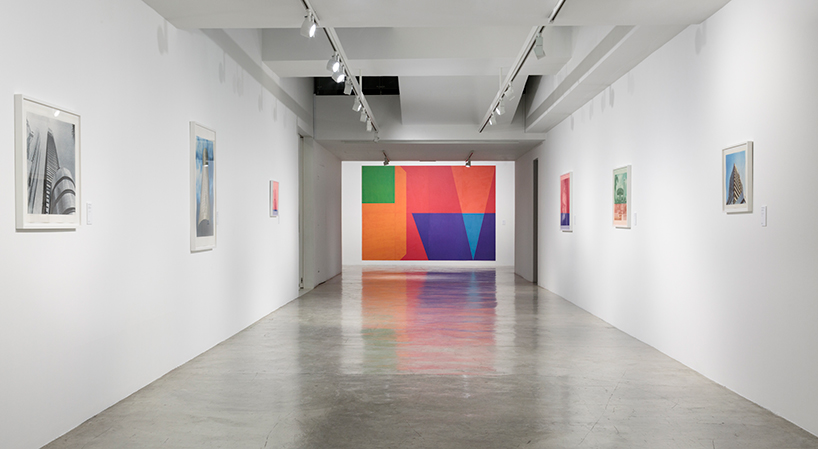
installation view, ‘exquisite trust (blindly collective collaborations)’ by carsten höller, tobias rehberger, anri sala &
rirkrit tiravanija. produced at STPI – creative workshop & gallery, singapore © the artists/STPI
tobias rehberger
designboom: can you elaborate on the ways your work aims to disrupt viewers’ initial perception of objects and their functions?
tobias rehberger: the ‘free’ prints that I made are a good example because when you see them, you think it’s an abstract composition, but it’s actually a composition that composed itself, because it’s a certain type of typography. the focus of it is always in the word ‘free’ which is made in the papers, and the print that goes on top can be anything. you’re used to seeing an artwork and immediately interpreting it, but there’s always something else behind it. that’s what I’m generally interested in, that things are not necessarily what you think they are, there’s always another layer, always another way of thinking (about) and seeing them, interpreting them, using them.
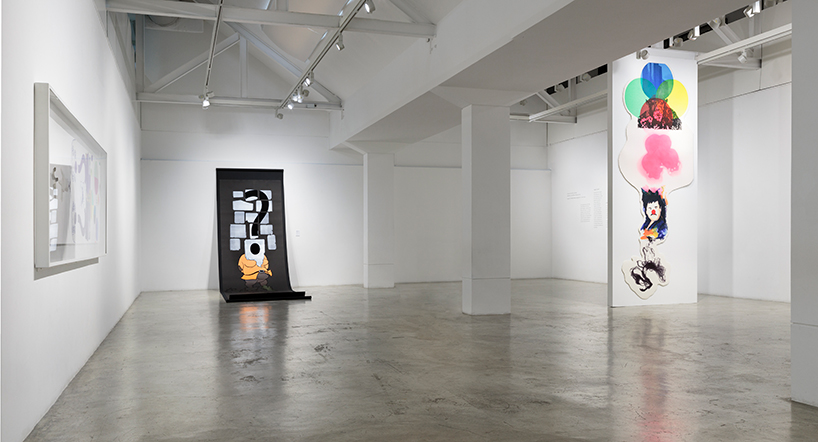
installation view, ‘exquisite trust (blindly collective collaborations)’ by carsten höller, tobias rehberger, anri sala &
rirkrit tiravanija. produced at STPI – creative workshop & gallery, singapore © the artists/STPI
DB: you work a lot with graphic sculptures and environments: how did you translate this immersive, tactile mode of operating into a more 2D iteration as part of ‘exquisite trust’?
TR: I have a lot of 2-dimensional work and for me the approach is not different. I use the ‘free’ prints here again as an example. the way that they are installed, without a frame, it’s a hint that it’s an object, a sculpture, a part of our real world. not the idea of the image as a window into another world. it’s meant to be part of this and dealt with like anything else. in a way, the smallest object is an installation in itself, as it stands with a context, and this is always important for how you’re able to use the work.
DB: did you find it frustrating or freeing to hand your work over to another artist for completion?
TR: my ideal show would be artists making works for other artists in the canon of the other artists. for instance, I could make a couple of pieces for rirkrit but in the way he’s making them. I think it’s very interesting and fruitful. it kind of liberates you from a lot of stuff you’re carrying around as you understand what somebody else is doing. I think that would be very nice, it’s not frustrating at all, it’s almost a relief.
DB: what do you think of the final outcomes?
TR: I think it’s interesting how predictable some of the works are. and others are completely unpredictable. maybe this has to do with which work we worked on first. you can really see a development.

transgender question seafood vaporiser, 2016, carsten höller, tobias rehberger, anri sala & rirkrit tiravanija,
produced at STPI – creative workshop & gallery, singapore © the artists/STPI
rirkrit tiravanija
designboom: the idea of a collaborative event is very much at the core of your work, but usually takes place between you and your audience, or between audience members themselves. how does this relationship change when you’re working collaboratively with other artists?
rirkrit tiravanija: I’ve actually done work with a lot of other artists, it’s just maybe you don’t see it like that. we talk to each other all the time, so we’re always thinking together. I would say that most of the work I’m doing comes from talking to other artist friends. in that way, it seems to me like a very normal thing, working with other people.
DB: through your cooking performances, you offer a re-interpretation of the function of otherwise everyday objects — like stoves, chairs or pots. how did the surrealist aspect of this project, particularly the surrealist ‘sculptural assemblage’, tie into your own art making?
RT: I guess for me it’s always about questioning your consciousness. it’s always a matter of being asleep or awake and I’m quite interested in is the relationship to language. how metaphoric language comes into play.
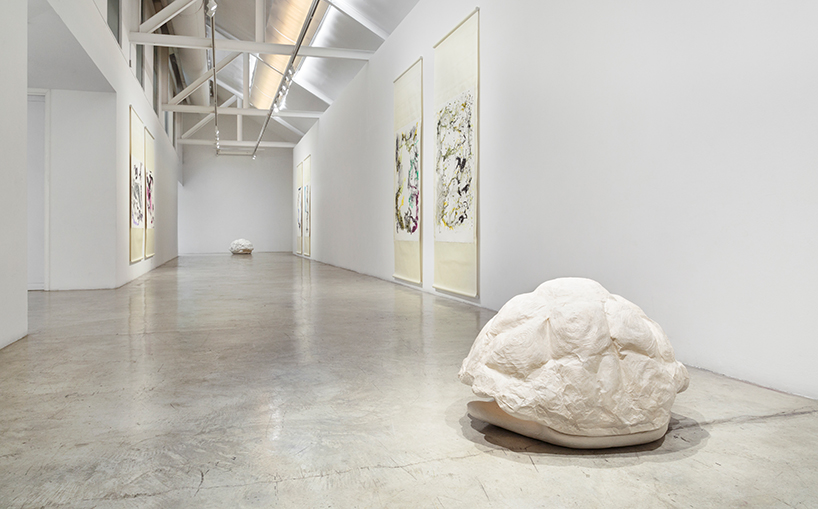
installation view, ‘exquisite trust (blindly collective collaborations)’ by carsten höller, tobias rehberger, anri sala &
rirkrit tiravanija. produced at STPI – creative workshop & gallery, singapore © the artists/STPI
DB: how did not being able to communicate with the other artists throughout the process affect your idea of a collaborative artistic experience?
RT: we always talk to each other; we just don’t tell each other what we’re doing. it doesn’t affect the work much. we know each other well so we can imagine what the other is doing anyway. but it’s also about not thinking too much, and letting things be surprising.
DB: how did knowing the identities of other artists affect your own contribution?
RT: I would say, of course, even knowing what they’re like and what they do doesn’t necessarily mean I’ll know exactly what will happen. in a way, we’re also trying to surprise ourselves, so it’s not like we’re going to do everything that we normally do anyway. what’s interesting about this is also that it’s an opportunity to do something that you don’t do every day.
DB: what do you think of the final outcomes?
RT: I think it looks good. exquisite corpse can be very fast; you can make drawings spontaneously and pass it around. this slow process is very different. in this case, we had a lot of time between things and we’re talking about doing some things a bit more quickly too.
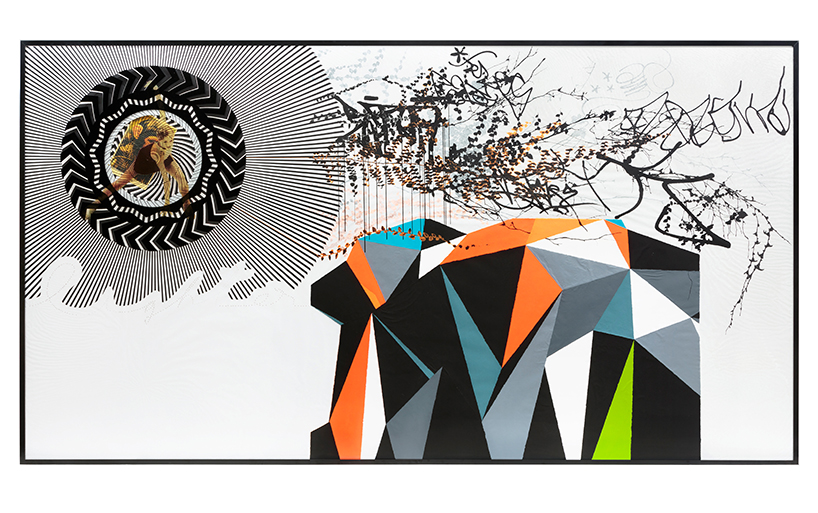
jitterbugs tangofly tagplants, 2016, carsten höller, tobias rehberger, anri sala & rirkrit tiravanija,
produced at STPI – creative workshop & gallery, singapore © the artists/STPI
carsten höller
DB: how did you find the experience of collaborating with different artists on a single piece of work, and what for you was the most important element of this technique?
CH: the process is very fantastical. it forces randomness into the picture, and you as a producer are forced to almost obey something that has been given to you. only it is given and not given at the same time because you don’t see the whole picture, just a tiny bit of it. we don’t know what the other is doing, save for the little hints we’re meant to develop on. we are in this common experience of not knowing, and what we show as a result of this cadavre exquis is the product of that. I found it very important to be there physically, because it’s not just the process. it’s also about being there together, even though we’re not sitting together all the time and exchanging ideas. it’s very different.
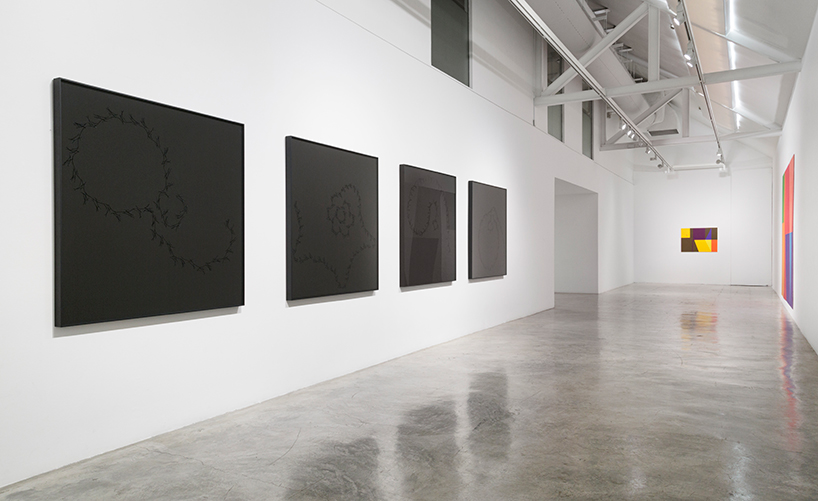
installation view, ‘exquisite trust (blindly collective collaborations)’ by carsten höller, tobias rehberger, anri sala &
rirkrit tiravanija. produced at STPI – creative workshop & gallery, singapore © the artists/STPI
anri sala
DB: can you give us an impression of what the collaborative process was like for you, and what effect you think this will have on the viewer?
AS: this project is a project of ruptures, and it’s about producing some kind of continuity amidst ruptures. I guess you can say it’s like making a song with four bridges, where there is no chorus, no verse, no intro. the result? no one knows, but I expect nonetheless that it will be made of plenty of bridges such that it will be the visitors who will bring their own choruses and verses to the plate.
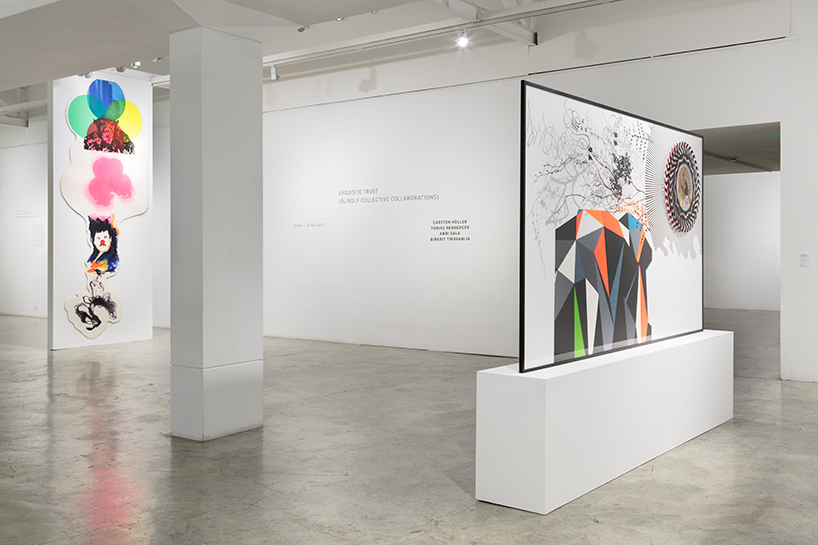
installation view, ‘exquisite trust (blindly collective collaborations)’ by carsten höller, tobias rehberger, anri sala &
rirkrit tiravanija. produced at STPI – creative workshop & gallery, singapore © the artists/STPI
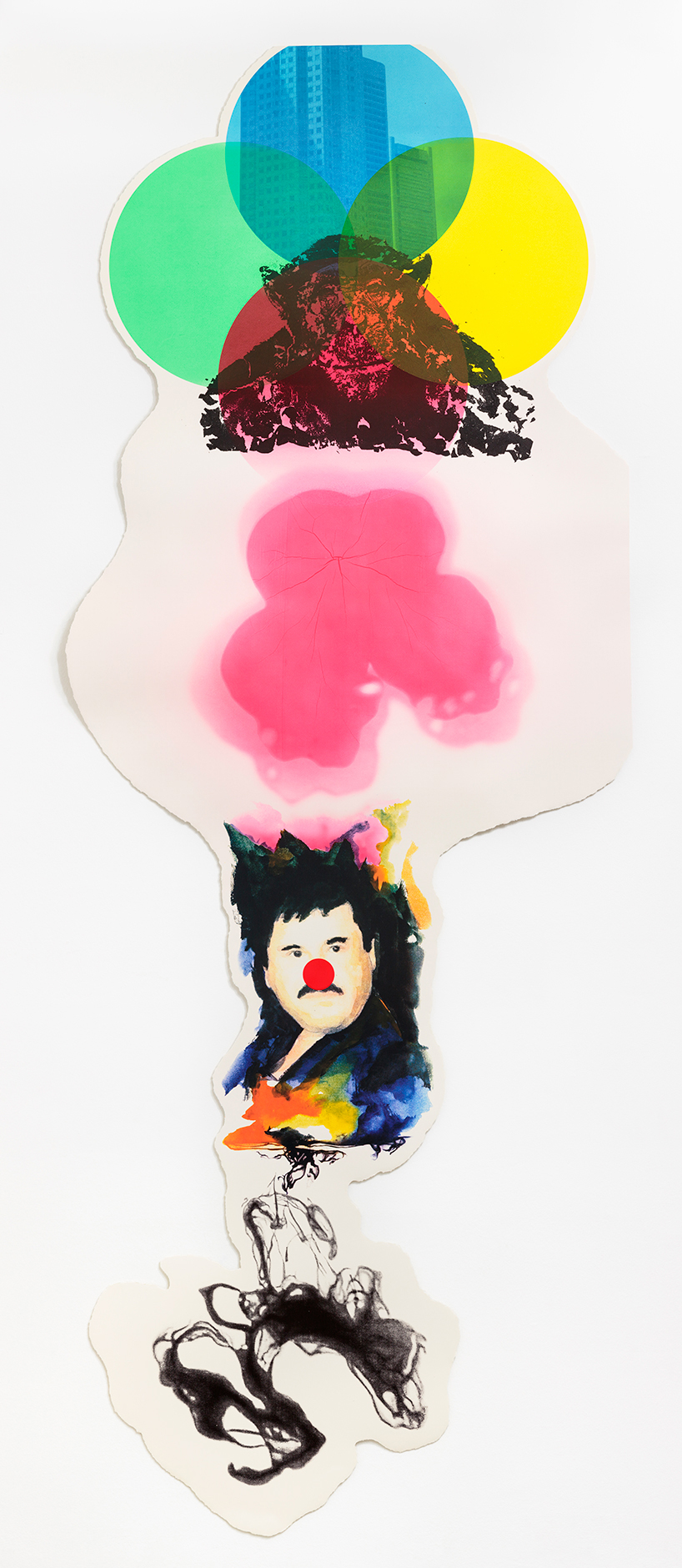
(dreams that money cannot buy), carsten höller, tobias rehberger, anri sala & rirkrit
tiravanija, produced at STPI – creative workshop & gallery, singapore © the artists/STPI
carsten holler (25)
tobias rehberger (5)
PRODUCT LIBRARY
a diverse digital database that acts as a valuable guide in gaining insight and information about a product directly from the manufacturer, and serves as a rich reference point in developing a project or scheme.
